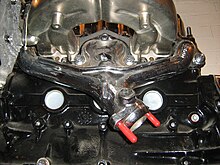재귀 파티셔닝
Recursive partitioning재귀 분할은 다변량 분석을 위한 통계적 방법이다.[1]재귀적 분할은 여러 이분법적 독립 변수에 기초하여 하위 모집단으로 분할함으로써 모집단의 구성원을 올바르게 분류하기 위해 노력하는 의사결정 트리를 만든다.각 하위 집단은 특정 정지 기준에 도달한 후 분할 프로세스가 종료될 때까지 무한정 여러 번 분할될 수 있기 때문에 이 프로세스는 재귀적이라 불린다.

재귀 분할 방법은 1980년대부터 개발되어 왔다.잘 알려진 재귀 분할 방법으로는 로스 퀸랜의 ID3 알고리즘과 그 후계자 C4.5와 C5.0, 분류 및 회귀 트리(CART)가 있다.랜덤 포레스트와 같은 앙상블 학습 방법은 서로 다른 알고리즘을 채택하고 어떤 방식으로든 출력을 결합함으로써 이러한 방법의 공통적인 비판(데이터의 과잉 피팅에 대한 취약성)을 극복하는 데 도움이 된다.
이 기사는 의료 진단 테스트를 위한 재귀적 분할에 초점을 맞추고 있지만, 이 기술은 훨씬 더 광범위한 응용을 가지고 있다.결정 트리를 참조하십시오.
의료 제공자가 환자가 병에 걸릴 확률을 계산하는 데 사용할 수 있는 공식을 만드는 회귀 분석과 비교했을 때, 재귀적 분할은 '환자가 x, y 또는 z를 발견한 경우 그들은 아마도 질병 q를 가지고 있을 것'과 같은 규칙을 만든다.
변동은 'Cox 선형 재귀 분할'[2]이다.
장단점
다른 다변량 방식에 비해 재귀 분할은 장단점이 있다.
- 장점은 다음과 같다.
- 단점은 다음과 같다.
- 연속형 변수에[5] 대해 잘 작동하지 않음
- 데이터를 오버핏할 수 있음.
예
진단 테스트 연구에 재귀적 파티셔닝을 사용하는 예는 다음과 같다.[6][7][8][9][10][11]골드만은 재귀 파티셔닝을 이용해 응급실 가슴통증 환자 중 심근경색 진단 시 민감도를 우선시했다.[11]
참고 항목
참조
- ^ Breiman, Leo (1984). Classification and Regression Trees. Boca Raton: Chapman & Hall/CRC. ISBN 978-0-412-04841-8.
- ^ a b Cook EF, Goldman L (1984). "Empiric comparison of multivariate analytic techniques: advantages and disadvantages of recursive partitioning analysis". Journal of Chronic Diseases. 37 (9–10): 721–31. doi:10.1016/0021-9681(84)90041-9. PMID 6501544.
- ^ James KE, White RF, Kraemer HC (2005). "Repeated split sample validation to assess logistic regression and recursive partitioning: an application to the prediction of cognitive impairment". Statistics in Medicine. 24 (19): 3019–35. doi:10.1002/sim.2154. PMID 16149128.
- ^ Kattan MW, Hess KR, Beck JR (1998). "Experiments to determine whether recursive partitioning (CART) or an artificial neural network overcomes theoretical limitations of Cox proportional hazards regression". Comput. Biomed. Res. 31 (5): 363–73. doi:10.1006/cbmr.1998.1488. PMID 9790741.
- ^ Lee JW, Um SH, Lee JB, Mun J, Cho H (2006). "Scoring and staging systems using cox linear regression modeling and recursive partitioning". Methods of Information in Medicine. 45 (1): 37–43. doi:10.1055/s-0038-1634034. PMID 16482368.
- ^ Fonarow GC, Adams KF, Abraham WT, Yancy CW, Boscardin WJ (2005). "Risk stratification for in-hospital mortality in acutely decompensated heart failure: classification and regression tree analysis". JAMA. 293 (5): 572–80. doi:10.1001/jama.293.5.572. PMID 15687312.
- ^ Stiell IG, Wells GA, Vandemheen KL, et al. (2001). "The Canadian C-spine rule for radiography in alert and stable trauma patients". JAMA. 286 (15): 1841–8. doi:10.1001/jama.286.15.1841. PMID 11597285.
- ^ Haydel MJ, Preston CA, Mills TJ, Luber S, Blaudeau E, DeBlieux PM (2000). "Indications for computed tomography in patients with minor head injury". N. Engl. J. Med. 343 (2): 100–5. doi:10.1056/NEJM200007133430204. PMID 10891517.
- ^ Edworthy SM, Zatarain E, McShane DJ, Bloch DA (1988). "Analysis of the 1982 ARA lupus criteria data set by recursive partitioning methodology: new insights into the relative merit of individual criteria". J. Rheumatol. 15 (10): 1493–8. PMID 3060613.
- ^ Stiell IG, Greenberg GH, Wells GA, et al. (1996). "Prospective validation of a decision rule for the use of radiography in acute knee injuries". JAMA. 275 (8): 611–5. doi:10.1001/jama.275.8.611. PMID 8594242.
- ^ a b Goldman L, Weinberg M, Weisberg M, et al. (1982). "A computer-derived protocol to aid in the diagnosis of emergency room patients with acute chest pain". N. Engl. J. Med. 307 (10): 588–96. doi:10.1056/NEJM198209023071004. PMID 7110205.


